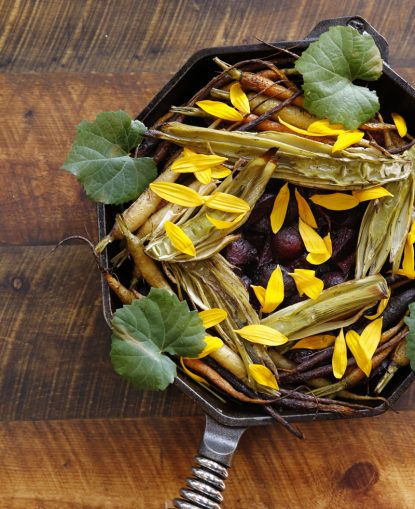
A dish of roasted root vegetables is ready for a Thanksgiving Day feast featuring foods from local farms, ranches and purveyors in Arizona. The first Thanksgiving was a celebration of survival, of gifts, of sharing and of gratitude. Colonists and Native Americans feasted on deer meat, fish, clams, fowl and corn — food they collected from nearby and from planting. (CNS photo/Nancy Wiechec)
If we take the lead from the first Thanksgiving, our holiday tables should feature the food and people close to us.
Pilgrims came to the New World knowing little about how to fend for themselves in the new land. They fled England as religious separatists and traveled across waters for new prosperity. But half the Mayflower’s hundred or so passengers died during their first New England winter, a particularly harsh one.
The remaining Pilgrims did better only after the indigenous people gave them direction in hunting, fishing, growing corn and storing stocks for winter. One can imagine that the Pilgrims, devout in their faith, were grateful to God for the native people who befriended them.
The first Thanksgiving (the name came later) was a celebration of survival, of gifts, of sharing and of gratitude. Colonists and Native Americans feasted on deer meat, fish, clams, fowl and corn — food they collected from hunts, fishing and planting.
What our technological society today calls the slow food movement has its roots in hunter-gatherer and small-farm communities.
I live in Flagstaff, Arizona. The mountain town is situated on the Colorado Plateau, which offers an abundance of game, farm fresh produce and animals fed from grassy ranch lands. There’s a huge diversity of life and people here.
Local restaurant Brix prides itself on cuisine made with ingredients from the Four Corners region — Arizona, New Mexico, Colorado and Utah. I asked Brix chef Logan Webber what might be on his Thanksgiving menu. Here’s what he came up using food solely from small Arizona farms and ranches.
[hotblock]
— Roasted guinea hen with autumn fruit
— Roasted baby carrots, beets and fennel with garam marsala
— Sweet potato gnocchi with chevre and sage
— Chestnut stuffing with fennel sausage and tart cherries
— Autumn greens salad with pickled apple vinaigrette, cranberries and walnuts
Unlike the salt-laden, too-sweet, heavy meal that we’re all used to, this Thanksgiving dinner is elegant, flavorful and a reminder that local food is better for you, better for the land and environment, and a tribute to those who toil to feeds us.
Like the Native Americans and Pilgrims, try sourcing your meal from what is abundant and nearby. Be grateful for the sustenance and the people around you, and enjoy.
Here is chef Webber’s stuffing recipe, utilizing sausage, bread and stock from local purveyors, and herbs and eggs from a nearby farm.
CHESTNUT AND SAUSAGE STUFFING:
Servings: 10, plus leftovers
1 1/2 pounds dried chestnuts
6 cups diced stale sourdough bread
4 tablespoons vegetable oil
2 medium onions, diced small
6 cloves garlic, minced
3 tablespoons unsalted butter
2 pounds sweet fennel sausage
3/4 cup whole milk
1 tablespoon minced fresh thyme
1 tablespoon minced fresh sage
1 tablespoon minced fresh parsley
1/2 cup dried tart cherries
1/2 cup cognac (optional)
3 eggs, lightly beaten
4 cups poultry stock
Kosher salt and fresh ground pepper to taste
Step 1 (day before serving)
Clean chestnuts (remove skins). Put chestnuts in small pot and cover with cold water. Simmer for 10 minutes, turn off heat and cool to room temperature. Transfer to refrigerator to soak overnight.
Step 2 (day before serving)
Heat oven to 275 degrees. Medium dice bread and season with salt and pepper and toss with vegetable oil. Toast bread on sheet pan for 20 minutes or until toasted, rotate pan halfway through cooking process. Leave out overnight to dry.
Step 3 (day of serving)
Heat oven to 425 degrees. Drain soaked chestnuts and chop in food processor (or by knife). Put chestnuts on sheet pan and toast for 30-40 minutes. Cool to room temperature.
Step 4 (day of serving)
Sweat onions and garlic in butter over medium heat until translucent. In separate pan, brown sausage and crumble with fork. Soak bread in milk for 10 minutes. Add sausage, sweated onions and garlic, herbs, cherries, cognac (if desired), eggs, chestnuts and half of the stock (use more if too dry) in baking dish. Toss all ingredients together, and season to taste.
Cover and cook for 35-45 minutes in the 425-degree oven, remove cover and finish for 15-20 minutes or until desired crust.
PREVIOUS: Look to the Psalms as models for gratitude
NEXT: Make your holiday holy, and maybe learn something new



Share this story